Short answer: To keep a sliced avocado from turning brown, immediately after slicing, submerge the pieces in a bowl of cold water mixed with half a teaspoon of salt. After soaking for five minutes, drain and store them in an airtight container in the refrigerator.
Avocados, with their rich, creamy texture and versatile flavor profile, is a favorite among many. However, one common issue encountered after slicing an avocado is its quick oxidation, which turns the flesh brown and can alter its taste. This browning effect is due to an enzyme present in avocados that reacts with oxygen when exposed to air. You can keep avocadoes from turning brown by submerging them in cold water with salt.
How To Keep Sliced Avocado From Turning Brown?
Method 1:
Step 1: Understand that avocado turn brown due to an enzyme called polyphenol oxidase, which reacts with oxygen to cause browning. This process is called oxidation.
Step 2:If you want to keep your avocado green, limit the fruit’s exposure to air.
Step 3:Store the leftover avocado in an airtight container and place it in the fridge. This method limits browning but doesn’t entirely stop it.
Step 4:For more complete prevention of oxidation, apply a barrier to the avocado’s flesh.
Step 5:Apply a coating of freshly squeezed lemon juice to the avocado’s exposed flesh. This forms a barrier between the avocado and the air. Note that this method may slightly adjust the avocado’s flavor.
Step 6:Alternatively, you can also use liquids like olive oil, avocado oil, or even water to form a barrier between the avocado flesh and the air.
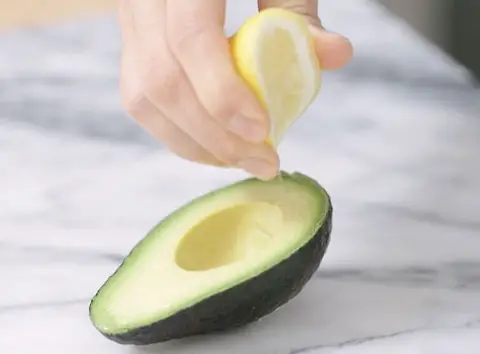
Step 7:To store an avocado using the lemon juice method, place the cut avocado in a container, squeeze enough lemon juice over it to create a coating, and then store it in an airtight container in the fridge.
Step 8:While the lemon juice method prevents browning, it’s important to remember that once you cut into an avocado, it’s best to consume it within the next couple of days.
Method 2:
Step 1:Start with a gallon of cold water and half a teaspoon of salt.
Step 2:Dissolve the salt in the water, preferably by adding the salt first and then filling it up with water.
Step 3:Cut your apples. For large batches, use a sectionizer or other suitable kitchen tool to speed up the process.
Step 4:As you cut the apples, add the slices directly into the saltwater solution.
Step 5:Let the apple slices rest in the saltwater solution for five minutes.
Step 6:After five minutes, drain the apple slices and place them back into a clean, dry container.
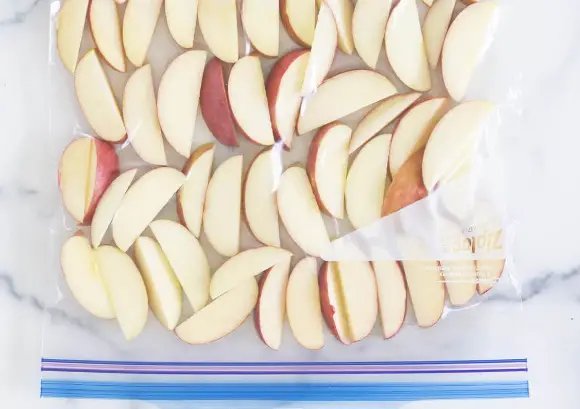
Step 7:Store the apple slices in an airtight container. These slices should stay bright and free from browning for up to three days when refrigerated.
Step 8: Remember to label and date the container before refrigerating.
Method 3:
Step 1: Start with your unripe avocados. If you dislike how quickly they ripen and turn brown, the key is to store them in the refrigerator. The cool temperatures will slow down both the ripening and browning processes.
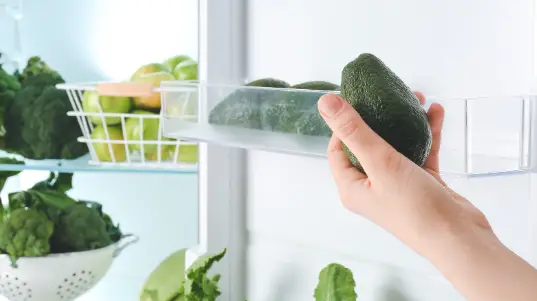
Step 1: Place all your unripe avocados in the refrigerator.
Step 2: Each day, remove one avocado from the refrigerator and place it on the counter.
Step 3: Allow this avocado to ripen at room temperature over a couple of days.
Step 4: By doing this, you ensure that you always have perfectly ripe avocados when you want one, and the remaining ones in the refrigerator won’t go bad before you get a chance to use them.
Method 4:
Step 1: Start with half of an avocado.
Step 2:Place the avocado in a container with enough water to fully submerge it.
Step 3:Place the container with the avocado in the refrigerator.
Step 4:Let the avocado sit in the water for 24 hours.
Step 5: After 24 hours, remove the avocado from the water. It should appear fresher and less brown compared to an avocado that was left out in the air.
How To Keep Avocado Fresh?
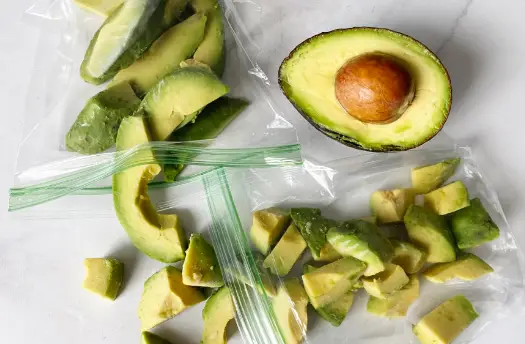
Step 1: Start with fresh, ripe avocados, lemon or lime juice, Ziploc freezer bags or large ice cube trays, an avocado masher, or a kitchen aid mixer.
Step 2: Cut open the avocados and scoop out the flesh into a large bowl or into the kitchen aid mixer bowl.
Step 3: Add one tablespoon of lemon or lime juice per avocado.
Step 4: Puree the mixture until smooth, avoiding leaving any chunks as they tend to turn brown.
Step 5: Spoon the puree into freezer bags, making sure to push out all air to prevent the puree from turning brown. A technique to remove all air is to partially submerge the bag in a large basin of water, with the weight of the water pushing out the air, then carefully close the bag just above the water level.
Step 6: If you’re using ice cube trays, place plastic wrap on top of the puree and push out all the air before freezing.
Step 7:Place the bags or trays in the freezer. The puree can be stored this way for up to a year.
Step 8: Before using, defrost the avocado puree. It can be used in guacamole, for a quick avocado toast, or as a sandwich spread.
How To Store Avocadoes?
Method 1:
Step 1:Start with a cut avocado, preserving the half that still has the pit in it. Also, have some chopped red onion on hand.
Step 2:Avocados are sensitive to light, air, and heat due to their high content of omega-3 fatty acids, which cause them to brown once cut. To prevent this, we’re going to utilize the avocado pit and the red onion.
Step 3:The reason onions make you cry when chopped is that they release sulfuric acid. This sulfuric acid helps to inhibit the avocado from browning.
Step 4:Place some of the chopped red onion in a small, airtight container.
Step 5:Add the avocado half, with its pit, into the container with the chopped red onion.
Step 6:Seal the container. This method should help to preserve the avocado for up to five days, if not more.
Method 2:
Step 1: Begin with a cut avocado that you wish to store for later.
Step 1: Begin with a cut avocado that you wish to store for later.
Step 2: Apply a thin film of oil on the surface of the avocado. You can use spray oil or regular oil (the example uses avocado oil, but olive oil works too).
Step 3: Wrap the avocado tightly in plastic wrap. Ensure the plastic is pressed against the surface of the avocado to reduce air exposure.
Step 4: Store the avocado in the refrigerator until the next day.
Step 5: When ready to use, unwrap the avocado. The top might have a slight tinge of oxidation, but the inside should still be green and fresh.
How To Mash Avocadoes And Keep Them From Turning Brown?
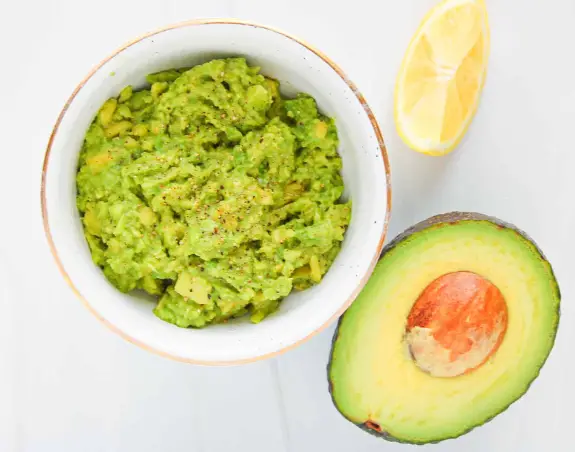
Step 1: Using a sharp knife, cut around the avocado but avoid cutting into the pit in the middle.
Step 2: Twist the two halves in opposite directions to separate them.
Step 3: Use a knife or a spoon to remove the pit from the avocado.
Step 4: Scoop out all the creamy flesh with a spoon and place it in a bowl.
Step 5: To prevent browning, add a dash of lemon juice to the avocado before you begin mashing it.
Step 6: Using a fork or a potato masher, mash the avocado until it reaches the desired texture, whether that’s smooth or chunky.
Step 7: If you’re planning to use all the mashed avocado in the next few hours, the lemon juice should be sufficient to prevent browning and keep the avocado fresh and green.
Step 8: However, if you want to save some for the following day, place the leftover mashed avocado in a sealable storage box and pat it down until it is smooth on the surface.
Step 9: Pour a thin layer of cold water on top of the mashed avocado or guacamole. Because of the avocado’s high-fat content, it won’t absorb the water or become soggy.
Step 10: Store this in the refrigerator. When you’re ready to use the mashed avocado, remove it from the fridge and pour away the water on top.
FAQs
How do you keep avocado fresh in sushi?
To keep avocado fresh in sushi, try brushing it with a bit of lemon or lime juice before adding it to the sushi roll. The citric acid in the juice slows down the oxidation process, which is what causes the avocado to brown.
How bad is it to consume an avocado that has gone brown?
While a brown avocado may not be visually appealing, it’s generally safe to eat. The browning is due to an enzymatic reaction that occurs when the avocado is exposed to air, which causes oxidation. However, if the avocado has dark spots or a foul odor, it may have gone bad and should not be consumed.
Why do fresh avocados turn black when exposed to air?
Avocados contain an enzyme called polyphenol oxidase, which causes the fruit to turn brown when exposed to air, a process known as enzymatic browning. This is the same process that causes apples, bananas, and other fruits to brown when cut open and left out.
How do restaurants keep guacamole from turning brown?
Restaurants often keep guacamole from turning brown by adding a healthy amount of lime or lemon juice, which slows the oxidation process. Some also store guacamole with a thin layer of water or plastic wrap directly on its surface to limit its exposure to air.
Can you eat brown guacamole?
Yes, you can eat brown guacamole. The browning is due to oxidation and doesn’t mean the guacamole has gone bad. However, it might have a slightly different flavor. If the guacamole has a sour smell or a moldy look, or if it’s been out of the fridge for a long time, it’s best not to eat it as it may have spoiled.
Conclusion
While avocados are a delicious and nutritious addition to your diet, their tendency to brown quickly once sliced can be a challenge. However, with simple, easy-to-follow methods like applying lemon juice or using cold water, you can effectively keep your sliced avocados fresh and green for longer. These methods ensure minimal waste and allow you to enjoy the creamy goodness of avocados at your convenience.

Mario Batali is a renowned author, food enthusiast, and passionate chef who has dedicated his life to exploring the world of culinary arts. With a love for sharing his knowledge and experiences, Mario has become a prominent figure in the food blogging community, inspiring countless readers with his creativity and expertise.
In addition to his culinary prowess, Mario Batali is also a talented writer with a flair for engaging storytelling. He launched his own food blog to share his recipes, cooking tips, and personal experiences in the kitchen. Over time, Mario’s blog gained a loyal following of food enthusiasts who appreciate his unique approach to cooking and his dedication to using only the finest ingredients.
Mario Batali’s passion for food and his commitment to sharing his knowledge with others have made him a true inspiration in the world of culinary arts. Through his blog, cookbooks, and public appearances, Mario continues to spread his love of food and the joy of cooking with his ever-growing fanbase.







